8 Real Estate Staging Tips to Sell Your Home Faster in 2025
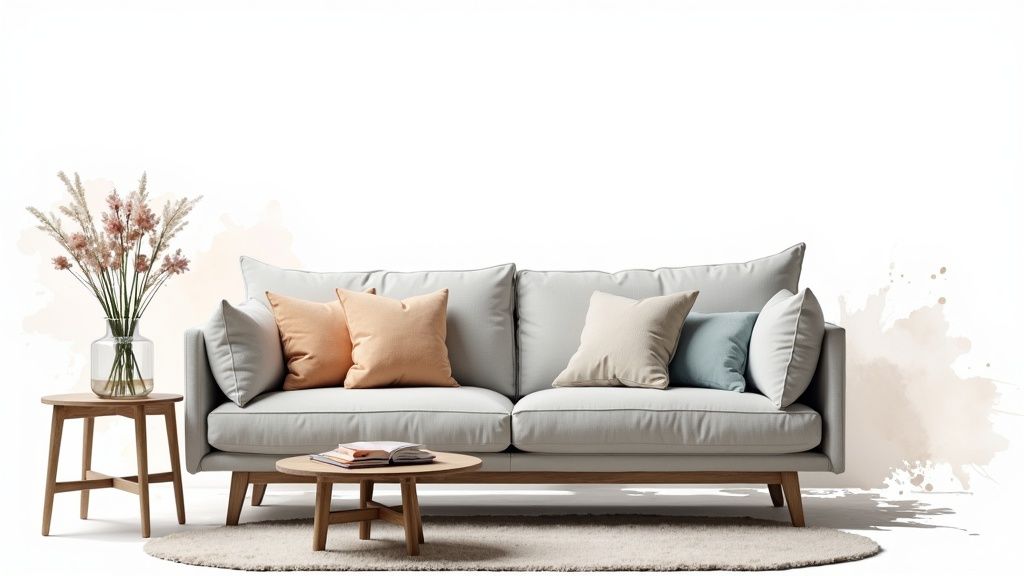
Selling your home is more than just a transaction; it’s about presenting a dream to potential buyers. In a competitive market, making a powerful first impression is non-negotiable. This is where strategic home staging comes in. It’s not about hiding flaws or extravagant makeovers; it’s the art of highlighting your property’s best features, creating an emotional connection, and allowing buyers to envision their future within its walls.
Effective staging can significantly reduce your home’s time on the market and substantially increase its final sale price. But where do you start? This comprehensive guide provides essential, actionable real estate staging tips that go beyond the basics. We’ll explore expert techniques to transform your space, from creating irresistible curb appeal and maximizing light to mastering the subtle psychology of color and furniture placement.
Forget generic advice. Instead, you’ll learn to strategically stage key rooms, declutter with purpose, and use accessories to create compelling focal points. By the end of this article, you’ll have a professional-grade roadmap to prepare your home for a faster, more profitable sale, ensuring every room communicates its maximum value to prospective buyers.
1. Tip 1: Master the Art of Decluttering and Depersonalizing
The first and most critical step in any successful home staging project is a thorough decluttering and depersonalizing process. This foundational stage transforms your lived-in ‘home’ into a desirable ‘house for sale’ by creating a blank canvas. The primary goal is to allow potential buyers to visualize themselves and their belongings in the space, which is impossible when your personal history is on full display. This involves a deep, systematic edit of everything from furniture and decor to personal keepsakes.
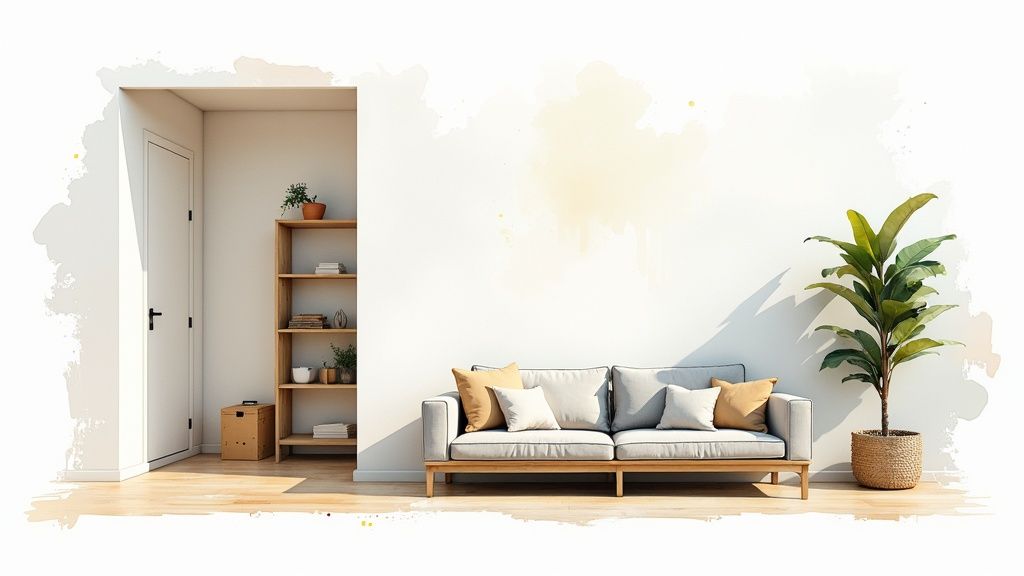
This essential real estate staging tip isn’t just about tidying up; it’s about strategically removing items to highlight the property’s best features, like architectural details and storage capacity. When buyers walk into a clean, neutral space, they focus on the home itself, not the seller’s life. A condo in Manhattan, for example, received multiple offers after the owner cleared cluttered kitchen counters and overstuffed bookcases, making the space feel significantly larger and more functional.
How to Implement This Strategy
To effectively declutter and depersonalize, you need a clear plan. A significant portion of your belongings may need to be packed away before your home is listed. As you sort through items, you may need to consider finding temporary storage options to house everything until you move.
Follow these actionable steps for a smooth process:
- Start Small: Tackle one room, or even one corner, at a time to prevent feeling overwhelmed.
- Remove Personal Items: Pack away all family photos, diplomas, collectibles, and religious items.
- Clear Surfaces: Countertops, mantels, and tables should be mostly clear. Follow a “one-in, two-out” rule for decorative objects.
- Showcase Storage: Remove at least half of the items from every closet, cabinet, and pantry to create an illusion of abundant storage space.
- Edit Furniture: Take out any bulky, worn, or excess furniture that makes rooms feel cramped. The goal is to improve flow and maximize the perception of square footage.
2. Maximize Natural Light and Lighting
After decluttering, the next most impactful staging element is to enhance your home’s lighting. A bright, well-lit space feels larger, cleaner, and more welcoming to potential buyers. The goal is to create a cheerful and inviting atmosphere by maximizing natural light during the day and supplementing it with a strategic, layered lighting plan. This powerful real estate staging tip can dramatically alter the perception of a room, making it feel more valuable and emotionally appealing.
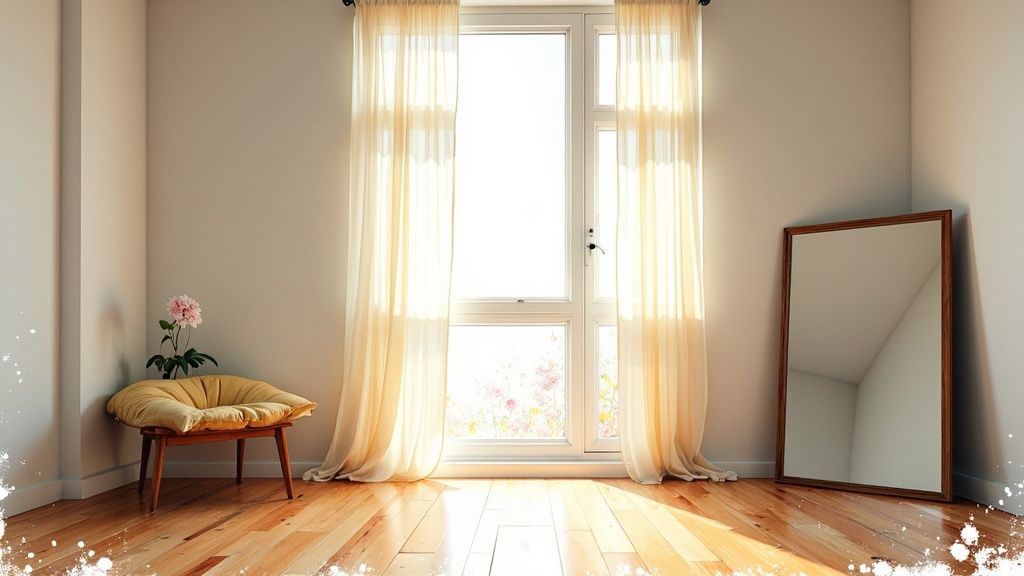
This strategy isn’t just about flipping a switch; it’s about creating an experience that highlights your home’s best features and minimizes its flaws. A well-lit home photographs better for online listings, drawing more interest and leading to more showings. For example, a Victorian home in San Francisco sold significantly faster after the sellers installed simple under-cabinet lighting, which illuminated the dark granite countertops and made the kitchen feel modern and functional. The strategic use of light can turn a dark, overlooked space into a celebrated feature.
How to Implement This Strategy
A successful lighting strategy involves a multi-pronged approach that addresses both natural and artificial light sources. The key is to create a consistent, bright environment throughout the entire property, from the main living areas to the smallest closets. Before your first showing, walk through every room and assess its lighting at different times of the day.
Follow these actionable steps for a brighter home:
- Embrace Natural Light: Open all curtains and blinds completely. Remove heavy, dark drapes and replace them with sheer or light-colored alternatives.
- Upgrade Bulbs: Replace any dim or mismatched bulbs with bright, energy-efficient LEDs. Use a consistent color temperature (soft white or daylight) throughout the house for a cohesive look.
- Add Supplemental Lighting: Place table lamps and floor lamps in rooms with limited overhead lighting or in dark corners to create warm, inviting pools of light.
- Clean Everything: Dust all light fixtures, lampshades, and bulbs. Wash windows inside and out to let in the maximum amount of natural sunlight.
- Illuminate Hidden Spaces: Consider using affordable, battery-operated LED lights in dark closets, pantries, and under cabinets to showcase storage areas.
3. Create Focal Points in Each Room
Once a home is decluttered, the next step is to strategically direct a buyer’s gaze. Creating a distinct focal point in each room is a powerful real estate staging tip that provides visual hierarchy and gives each space a clear purpose. This technique involves arranging furniture, art, and decor to highlight a room’s best asset, whether it’s an architectural feature like a fireplace or a stunning view. The goal is to create an immediate, positive impression that draws buyers in and helps them connect emotionally with the space.
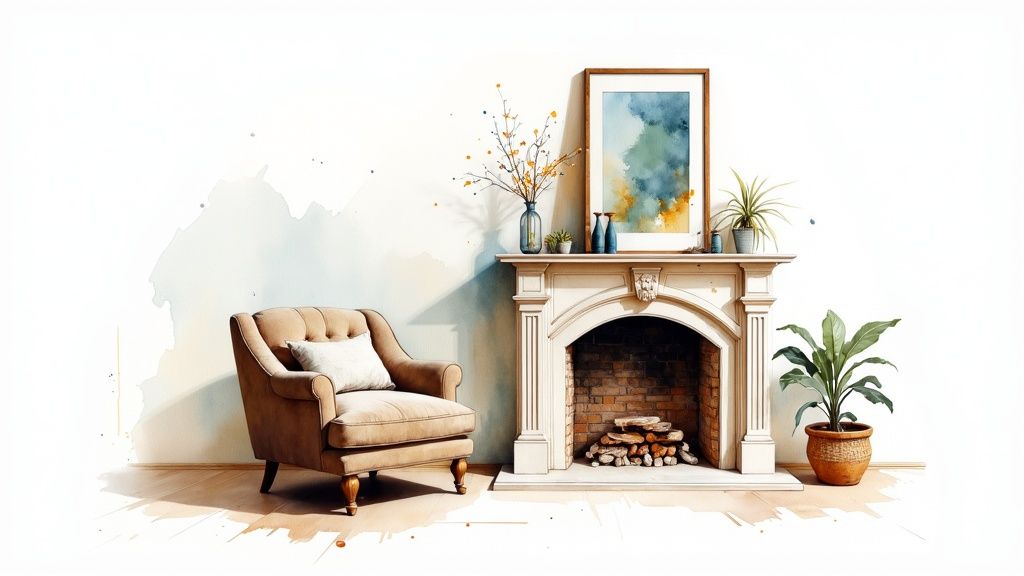
This method, often used by high-end staging companies like Meridith Baer Home, prevents a room from feeling flat or confusing. A well-defined focal point anchors the space and makes it memorable. For example, a master bedroom in a Miami condo might position the bed to directly face large windows, showcasing a desirable ocean view. Similarly, a living room in a Denver home could have furniture angled toward a beautifully styled fireplace, instantly conveying warmth and comfort.
How to Implement This Strategy
To establish effective focal points, you must first identify the most compelling feature of each room and then build your staging design around it. The key is to create a clear and uncluttered visual path to that feature from the moment someone enters the room.
Follow these actionable steps to create compelling focal points:
- Identify the Star: Determine the room’s best feature. This could be a large window, a fireplace, built-in shelving, or even a feature wall.
- Arrange Furniture Strategically: Position the main furniture pieces to face or frame the focal point. For instance, angle sofas and chairs toward the fireplace instead of pushing them against the walls.
- Use Art and Mirrors: If a room lacks a natural focal point, create one. A large piece of art or an elegant mirror can serve as a powerful anchor on a prominent wall.
- Layer the Lighting: Use a combination of ambient, task, and accent lighting to draw attention. A spotlight on a piece of art or pendant lights over a kitchen island can be highly effective.
- Keep it Simple: The focal point should be the star of the show. Avoid cluttering the area with too many decorative items, which can dilute its impact and distract the buyer.
4. Use Neutral Colors and Fresh Paint
One of the most impactful and cost-effective real estate staging tips is to apply a fresh coat of neutral paint. This simple act can dramatically transform a home by creating a clean, bright, and updated atmosphere that appeals to the widest possible audience of buyers. The goal is to neutralize the space, moving away from bold or taste-specific colors that might distract or deter potential owners. A neutral palette provides a blank canvas, helping buyers to envision their own furniture and decor in each room without being influenced by the seller’s personal style.
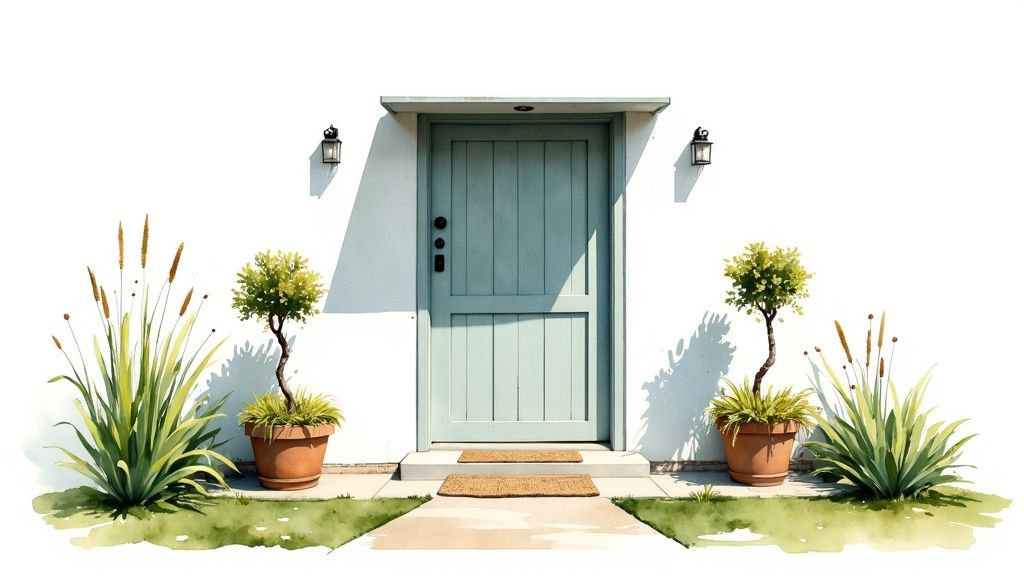
The power of paint extends beyond just aesthetics; it makes a home feel well-maintained and move-in ready. For instance, a dated 1970s home in Seattle, once defined by its dark wood paneling and yellow walls, was updated with Sherwin Williams Accessible Beige. This single change made the interior feel larger and more modern, resulting in a sale price 10% above asking. Similarly, a rental property in Atlanta saw a significant value increase after the owner painted over a tenant’s bold, eclectic wall colors with a calming, neutral gray, attracting a higher class of offers.
How to Implement This Strategy
Choosing the right paint is crucial for creating an inviting and cohesive look. While “neutral” is the goal, this doesn’t mean everything must be stark white. Warm, contemporary neutrals are often the best choice. Before committing, it’s wise to learn more about how to choose the right color schemes to ensure the shades complement your home’s unique features.
Follow these actionable steps for a professional-looking finish:
- Test Your Colors: Paint large sample swatches on different walls in a room and observe how they look in natural and artificial light throughout the day.
- Pick Popular Staging Colors: Proven favorites include Benjamin Moore Cloud White, Sherwin Williams Agreeable Gray, and Sherwin Williams Accessible Beige.
- Don’t Forget Trim and Ceilings: A fresh coat of crisp white on ceilings, baseboards, and trim will make your chosen wall color pop and create a polished look.
- Consider Your Flooring: Select a neutral paint color that complements the undertones in your existing flooring, whether it’s carpet, tile, or hardwood.
- Hire a Professional: If your time or skills are limited, hiring professional painters is a worthwhile investment to ensure a flawless, high-quality result.
5. Optimize Furniture Placement and Flow
How you arrange your furniture is one of the most impactful real estate staging tips for influencing a buyer’s perception of a home. Strategic placement goes beyond aesthetics; it’s about creating an intuitive flow, maximizing the perceived square footage, and clearly demonstrating the function of each room. Poorly arranged furniture can make a space feel cramped and awkward, while the right layout makes it feel open, inviting, and easy to navigate.
The goal is to guide a buyer’s eye through the space, highlighting its best features without obstruction. A successful arrangement allows buyers to move freely and envision their own lives unfolding within the walls. For instance, an open-concept home in Dallas used large area rugs to define separate living and dining zones, giving purpose to a vast space. Similarly, a small NYC apartment staged with appropriately scaled, multi-functional furniture attracted young professionals by showcasing how to live comfortably and stylishly in a compact footprint.
How to Implement This Strategy
Optimizing flow often means removing pieces rather than adding them. Take an objective look at each room and consider how a potential buyer will walk through it. Your goal is to eliminate obstacles and create clear, defined pathways that make the home feel spacious and logical. For a deeper dive, you can explore detailed guides on how to arrange living room furniture for maximum appeal.
Follow these actionable steps for a professional-looking layout:
- Remove Oversized Pieces: Store or sell any bulky furniture that dominates a room and makes it feel smaller.
- Define Zones with Rugs: Use area rugs to anchor furniture and define distinct functional areas, such as a conversation nook or a reading corner, especially in open-plan homes.
- Create Intimate Seating: In large living rooms, pull furniture away from the walls and arrange it into cozy, conversational groups to make the space feel more welcoming.
- Angle for Interest: Instead of pushing everything flat against the walls, try angling a chair or a small table to create a more dynamic and sophisticated arrangement.
- Ensure Proper Spacing: Maintain clear traffic paths of at least 30-36 inches wide and ensure there are 14-18 inches between a sofa and a coffee table for comfort.
- Check Functionality: Before a showing, confirm that all doors, cabinets, and drawers can open fully without being blocked by furniture.
6. Enhance Curb Appeal and First Impressions
The very first judgment a buyer makes about your property happens before they even step inside. Enhancing your home’s curb appeal is a critical real estate staging tip because it sets the tone for the entire showing, creating a powerful and positive first impression. This involves a comprehensive approach to your home’s exterior, from landscaping and maintenance to entryway styling, ensuring the property looks inviting, well-maintained, and appealing from the street.
A compelling exterior can significantly impact a home’s perceived value and a buyer’s interest level. A well-presented facade suggests that the rest of the home is equally cared for, building buyer confidence from the outset. For instance, a Victorian home in Charleston sold quickly after the owners painted the front door a bold navy blue and updated the porch lighting, creating a memorable and stylish focal point that attracted significant attention. This simple update transformed the home’s initial impact.
How to Implement This Strategy
To effectively boost curb appeal, focus on creating a clean, welcoming, and manicured look. This process involves addressing any visible exterior issues and adding thoughtful touches that make the property stand out. Achieving a lush, green yard is a major component, so be sure to follow some top lawn care and maintenance tips to impress potential buyers.
Follow these actionable steps for a stunning exterior:
- Power Wash Surfaces: Clean all walkways, driveways, siding, and decks to remove dirt and grime.
- Boost Landscaping: Keep the lawn mowed and edges trimmed, weed flower beds, and add fresh mulch. Symmetrical plantings or colorful container gardens flanking the front door add instant charm.
- Focus on the Front Door: Add a fresh coat of paint, replace or polish the door hardware, and hang a tasteful wreath.
- Update Fixtures: Ensure house numbers are modern and clearly visible. Replace or clean outdated exterior light fixtures.
- Create a Welcoming Entry: Add a new, clean doormat and remove any personal items, clutter, or dead plants from the front porch or stoop.
7. Stage Key Rooms Strategically
Not every room in a house holds the same weight in a buyer’s decision-making process. A targeted approach that focuses your time, budget, and effort on the most influential spaces is one of the most effective real estate staging tips. The goal is to make a powerful first impression in the rooms where buyers spend the most time and form critical emotional connections, namely the main living areas, kitchen, master bedroom, and primary bathroom. This strategic allocation of resources maximizes your staging impact where it matters most.
This method ensures your staging budget delivers the highest possible return on investment. Buyers often make purchase decisions based on their gut feeling about these key zones. For instance, a family home in suburban Chicago saw a significant increase in interest after the owners converted two small, cluttered children’s rooms into a polished home office and a serene guest room. This simple change broadened the property’s appeal by showcasing its versatility to a wider range of potential buyers.
How to Implement This Strategy
To stage key rooms strategically, you must first identify which areas will resonate most with your target demographic. This ensures that when these rooms are photographed, they tell a compelling story about the lifestyle the home offers. You can learn more about capturing these spaces effectively to support your staging efforts.
Follow these actionable steps for maximum impact:
- Prioritize the Kitchen: As the heart of the home, the kitchen must be immaculate. Clear countertops, add a bowl of fresh fruit, and ensure all fixtures are gleaming.
- Create a Living Room Focal Point: Arrange furniture to highlight the room’s best feature, like a fireplace or a large window, creating an inviting conversation area.
- Transform the Master Bedroom: Style this room to feel like a tranquil, hotel-like retreat. Use luxurious, neutral bedding, soft lighting, and minimal decor.
- Style Bathrooms Like a Spa: Clear all personal toiletries. Display fresh, folded white towels, a new bar of soap, and perhaps a small plant or orchid.
- Don’t Forget First Impressions: The entryway is the first interior space buyers see, so ensure it is bright, welcoming, and clutter-free.
8. Add Strategic Accessories and Styling
Once the larger elements like furniture and paint are in place, the final layer of strategic accessorizing is what brings a staged home to life. This crucial step involves carefully selecting decor, artwork, and textiles that add warmth, personality, and a sense of a curated lifestyle without being overly personal. The goal is to create appealing vignettes and textural layers that help buyers connect emotionally with the property and envision the life they could live there.
This essential real estate staging tip is about adding the finishing touches that make a house feel like a well-designed home. These details guide the buyer’s eye and highlight the property’s best features. For example, an urban loft in Brooklyn can be enhanced with industrial-chic accessories like metal-framed art and minimalist sculptures that complement its architectural character. Similarly, a modern home in Seattle with water views might use a palette of blue and white accessories to subtly connect the interior with the stunning exterior landscape.
How to Implement This Strategy
Effective accessorizing is an art of balance; it’s about adding just enough detail to create interest without causing clutter. The key is to choose items that are sophisticated, current, and appeal to a broad demographic. This is where you can subtly introduce on-trend colors and textures in a low-commitment way.
Follow these actionable steps for perfect styling:
- Follow the Rule of Threes: Group decorative items in odd numbers, particularly threes, on surfaces like coffee tables and mantels for a visually pleasing arrangement.
- Vary Heights and Shapes: When creating a vignette, combine objects of different heights, shapes, and textures to create depth and visual interest.
- Layer Textiles: Add new throw pillows in contemporary colors and patterns to sofas and beds. Drape a cozy throw blanket over a chair to add texture.
- Refresh Linens: Place fresh, fluffy white towels in bathrooms and crisp, neutral linens on beds to create a spa-like, luxurious feel.
- Use Books Strategically: Stack a few hardcover books to add color, intellectual appeal, and height to a side table or bookshelf display.
- Incorporate Greenery: Add a touch of life with carefully placed plants or a simple vase of fresh flowers. Ensure they are healthy and well-maintained.
Real Estate Staging Tips Comparison
| Staging Technique | Implementation Complexity 🔄 | Resource Requirements ⚡ | Expected Outcomes 📊 | Ideal Use Cases 💡 | Key Advantages ⭐ |
|---|---|---|---|---|---|
| Declutter and Depersonalize | Medium - Requires significant effort | Moderate - Time, possible storage costs | Creates neutral, spacious environment; broad appeal | Homes with many personal items; occupied homes | Enhances buyer connection; makes space appear larger |
| Maximize Natural Light and Lighting | Low to Medium - Simple changes with some maintenance | Low - LED bulbs, bulbs replacement, cleaning | Bright, welcoming rooms; improved photos and appeal | Homes with poor lighting or dark rooms | Cost-effective high-impact improvement |
| Create Focal Points in Each Room | Medium - Requires design understanding, possible accessory purchase | Medium - New furniture/accessories possible | Guides buyer attention; memorable room impressions | Rooms with multiple features or complex layouts | Enhances flow and functionality; professional look |
| Use Neutral Colors and Fresh Paint | Medium - Requires painting skills and time | Medium - Paint and supplies costs | Clean, updated look; appeals widely | Homes with outdated or bold colors | Makes spaces brighter; good for photos |
| Optimize Furniture Placement and Flow | Medium to High - Physical effort and planning needed | Medium to High - Possible furniture rental or purchase | Improves room function and perceived size | Small or awkwardly laid out spaces | Demonstrates potential; invites buyers in |
| Enhance Curb Appeal and First Impressions | Medium to High - May involve landscaping and maintenance | Medium to High - Possible landscaping/professional fees | Positive buyer first impressions; increases value | Homes relying on strong exterior appeal | Attracts more showings; sets high expectations |
| Stage Key Rooms Strategically | Medium - Focused efforts, may require professionals | Medium to High - Professional staging in key rooms | Maximizes staging ROI; emotional buyer connection | Homes with limited staging budget | Maximizes impact on buying decisions |
| Add Strategic Accessories and Styling | Medium - Requires sourcing and styling skills | Low to Medium - Cost of accessories | Adds warmth and personality without clutter | Neutral staged homes needing finishing touches | Enhances emotional appeal; relatively low cost |
Staging for Success: Your Next Steps to a Profitable Sale
You’ve explored the foundational pillars of preparing a property for the market, moving from the broad strokes of decluttering to the fine details of accessory placement. Each of the real estate staging tips we’ve covered is a crucial piece of a larger puzzle. Together, they transform a personal space into a marketable product, designed to capture the imagination and aspirations of potential buyers.
Staging is not about deception or hiding flaws; it is about highlighting potential. It’s the art of creating an emotional connection that allows a visitor to mentally move in before they’ve even made an offer. By implementing these strategies, you are not just cleaning a house; you are merchandising a high-value asset. The goal is to remove personal imprints and present a clean, inviting, and universally appealing canvas.
From Strategy to Sold: Key Takeaways
The journey from a lived-in house to a show-ready home can feel extensive, but its impact on your bottom line is undeniable. Remember these core principles as you begin your staging process:
- First Impressions are Final: Your efforts on curb appeal and the entryway set the tone for the entire showing. A welcoming exterior promises a well-maintained interior.
- Space is the Ultimate Luxury: Decluttering, optimizing furniture layout, and maximizing light all work together to create a feeling of spaciousness. This allows buyers to appreciate the home’s architecture and potential, not your personal belongings.
- Emotion Drives Decisions: Strategic use of neutral colors, defined focal points, and tasteful accessories creates a narrative. Buyers aren’t just purchasing walls and a roof; they are investing in a lifestyle.
Your Action Plan for a Higher Sale Price
Knowledge without action is just potential. To turn these real estate staging tips into a tangible return on investment, your next steps are critical. Start by creating a room-by-room checklist based on the eight key areas we’ve discussed. Prioritize tasks based on impact and budget, focusing first on high-traffic areas like the living room, kitchen, and primary bedroom.
Don’t be afraid to experiment with layouts or bring in an objective third party, like a friend or real estate agent, for feedback. Fresh eyes can spot details you’ve become accustomed to. By systematically addressing each element, from a fresh coat of paint to the strategic placement of a single vase, you are actively building equity and setting the stage for a swift, profitable sale. The effort you invest now will pay dividends when the offers start coming in, proving that exceptional staging is one of the smartest pre-sale investments you can make.
Feeling overwhelmed with layout options or color palettes? Take the guesswork out of your staging plan with RoomGenius. Our AI-powered tool helps you visualize different furniture arrangements and design concepts instantly, ensuring every room is staged to perfection. Visit RoomGenius to start designing a space that sells.